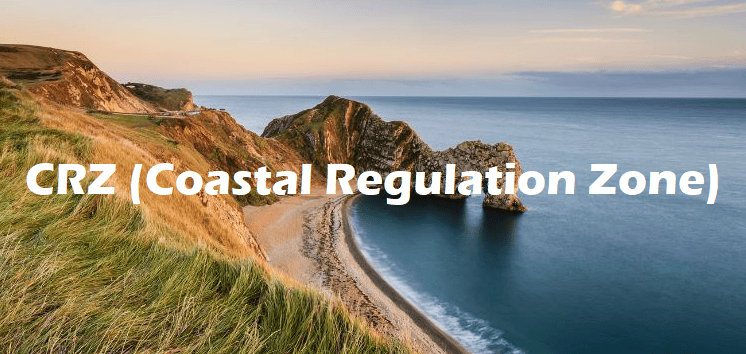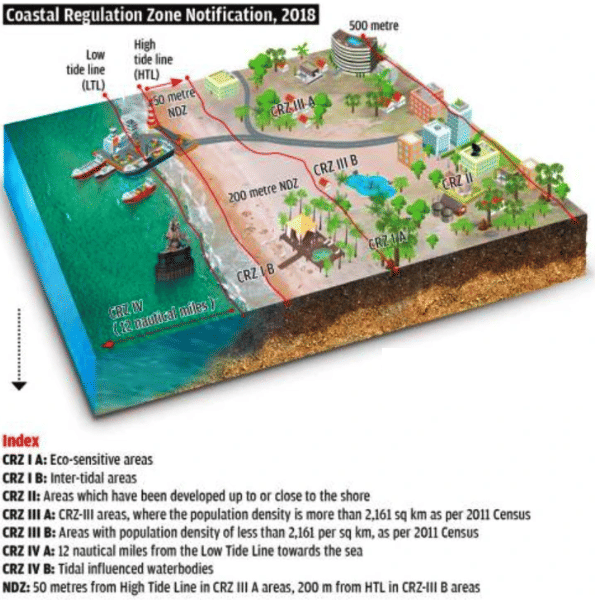CRZ (Coastal Regulation Zone) | Environmental Law - CLAT PG PDF Download
| Table of contents |

|
| Introduction |

|
| Basic Understanding of CRZ |

|
| Evolution of CRZ |

|
| Salient Features of CRZ Notification, 2018 |

|
| Crticisms |

|
Introduction
In 1991, the Ministry of Environment and Forests (MoEF) issued the Coastal Regulation Zone Notification (CRZ 1991) under the Environment (Protection) Act to safeguard coastal areas. The CRZ 1991 adopted a straightforward regulatory approach, aimed at allowing only activities that are essential to the coastal environment while restricting others. Coastal Regulation Zone areas were divided into different categories (CRZ-I, CRZ-II, CRZ-III, and CRZ-IV) based on ecological factors and the level of human settlement.
The responsibility for implementing the 1991 Notification was mainly given to State Governments, who were tasked with identifying and classifying CRZ areas in State Coastal Zone Management Plans (SCZMPs) and getting them approved by the MoEF.
Over time, it became clear that the CRZ 1991 faced significant implementation challenges due to various reasons:
- The notification applied uniform regulations even to unique and ecologically sensitive areas like the Andaman and Nicobar Islands.
- There were no proper clearance procedures for high-impact coastal activities.
- Lack of monitoring and enforcement mechanisms to check violations.
- Pollution from land-based activities was not addressed.
- The needs of traditional coastal communities in sensitive areas were overlooked.
- Frequent amendments (25 times in 19 years) often aimed at balancing increasing developmental demands with conservation, but critics argued that these changes weakened conservation standards.
- The CRZ Notification was largely ignored by State authorities responsible for its enforcement, as highlighted in legal cases like Indian Council for Enviro-Legal Action v. Union of India and S. Jagannath v. Union of India.
In response to these challenges, authorities attempted to improve the situation through various amendments and by establishing the National Coastal Zone Authority (NCZMA) and State Coastal Zone Authorities (SCZMA) for better administration and implementation of the CRZ Notification.
Basic Understanding of CRZ
- The coastal zone is a transition area between marine and territorial zones. It includes shore ecosystems, wetland ecosystems, mangrove ecosystems, mudflat ecosystems, seagrass ecosystems, salt marsh ecosystems, and seaweed ecosystems.
- CRZ Rules govern human and industrial activity close to the coastline to protect the fragile ecosystems near the sea.
- They seek to restrict certain kinds of activities, like large constructions, setting up of new industries, storage or disposal of hazardous material, mining, or reclamation and bunding, within a certain distance from the coastline.
- The basic idea is: As areas immediately next to the sea are extremely delicate, home to many marines and aquatic life forms, and are also threatened by climate change, they need to be protected against unregulated development.
- In all CRZ Rules, the regulation zone has been defined as the area up to 500 m from the high-tide line.
Evolution of CRZ
- The Rules, mandated under the Environment Protection Act, 1986, were first framed in 1991. However, it failed to take into account the concerns of coastal communities. Also, despite several amendments, states found the 1991 Rules to be extremely restrictive. The 1991 Rules created hurdles for showpiece industrial and infrastructure projects such as the POSCO steel plant in Odisha and the proposed Navi Mumbai airport.
- After a series of reviews and amendments, it was eventually replaced with a new notification in 2011. The Centre notified fresh CRZ Rules in 2011, which addressed some concerns. An exemption was made for the construction of the Navi Mumbai airport.
- District Level Coastal Committees (DLCC), space for coastal communities to participate in some aspects of regulatory decision-making on the coasts were created.
- After even these Rules were found inadequate, the Environment Ministry in 2014 set up a committee under Shailesh Nayak to give suggestions for a new set of CRZ Rules.
Salient Features of CRZ Notification, 2018
- Allowing FSI as per current norms in CRZ areas: As per CRZ, 2011 Notification, for CRZ-II (Urban) areas, Floor Space Index (FSI) or the Floor Area Ratio (FAR) had been frozen as per 1991 Development Control Regulation (DCR) levels. In the CRZ, 2018 Notification, it has been decided to de-freeze the same and permits FSI for construction projects.
- Densely populated rural areas to be afforded greater opportunity for development:For CRZ-III (Rural) areas, two separate categories have now been stipulated as below:
- CRZ-III A- These are densely populated rural areas with a population density of 2161 per square kilometer as per 2011 Census. Such areas shall have a No Development Zone (NDZ) of 50 meters from the HTL as against 200 meters from the High Tide Line stipulated in the CRZ Notification, 2011 since such areas have similar characteristics as urban areas.
- CRZ-III B- Rural areas with a population density of below 2161 per square kilometer as per 2011 Census. Such areas shall continue to have an NDZ of 200 meters from the HTL.

- Tourism infrastructure for basic amenities to be promoted: Temporary tourism facilities such as shacks, toilet blocks, change rooms, drinking water facilities, etc. have now been permitted in Beaches. Such temporary tourism facilities are also now permissible in the "No Development Zone" (NDZ) of the CRZ-III areas as per the Notification. However, a minimum distance of 10 m from HTL should be maintained for setting up of such facilities.
- CRZ Clearances streamlined: Only such projects/activities, which are located in the CRZ-I and CRZ IV shall be dealt with for CRZ clearance by the Ministry of Environment, Forest and Climate Change. The powers for clearances with respect to CRZ-II and III have been delegated at the State level with necessary guidance.
- A No Development Zone (NDZ) of 20 meters has been stipulated for all Islands: For islands close to the mainland coast and for all Backwater Islands in the mainland, in wake of space limitations and unique geography of such regions, bringing uniformity in treatment of such regions, NDZ of 20 m has been stipulated.
- All Ecologically Sensitive Areas have been accorded special importance: Specific guidelines related to their conservation and management plans have been drawn up as a part of the CRZ Notification.
- Pollution abatement has been accorded special focus: In order to address pollution in Coastal areas treatment facilities have been made permissible activities in CRZ-I B area subject to necessary safeguards.
- Boost tourism
- Enhanced employment opportunities
- Opportunities for affordable housing
- Promotion of economic growth
- Rejuvenation of the coastal areas while reducing their vulnerabilities.
Crticisms
- Facilitate Flagship Projects: The government has declared Sagarmala, Bharatmala, and CEZs as "strategic projects," which have a blanket exemption from CRZ provisions.
- Enhanced Coastal Vulnerabilities: Studies by the Indian National Centre for Ocean Information Services, say the sea level along India is rising at 0.33-5.16 mm per year and predict that the frequency and intensity of unseasonal and extreme weather events will increase in the coming decades.
- Enhanced Risk to Inhabitants: Providing housing facilities just 50 m from the coastline would expose the inhabitants to severe weather events, that too without any buffer.
- Increased Coastal Erosion: According to the Central Water Commission's Shoreline Change Atlas, India has lost 3,829 km, or 45 percent of the coastline, in just 17 years till 2006. While coastal erosion is a natural phenomenon carried out by waves, tidal and littoral currents and deflation, the report says these factors get exacerbated by activities like land reclamation and other structures on the coast.
- Disregard to Fragile Coastal Ecology: The controversial land reclamation, in which new land is created from oceans or lake beds and is known to have strong impacts on coastal ecology, has been allowed in intertidal or CRZ-IB areas, for ports and sea links.
- Increased Pollution Levels: Increasing nutrients in the coastal water may lead to ecological disturbances affecting the coastal ecosystem processes and services.
- Unscientific Approach: Government has relied on satellite imagery to demarcate CRZ categories with little or no corroboration on the ground.
- Local Communities Further Distanced: New notification brings clearance in CRZ-IV areas under the purview of the Centre. Earlier, the area was under the state government. Now, it will be difficult for communities to get their voices heard in Delhi.
- Non-Empirical Approach: No study is available to show the carrying capacity of coastal areas to accommodate such increased development or the projected impact of such a change on the coastal communities.
|
39 docs|15 tests
|
FAQs on CRZ (Coastal Regulation Zone) - Environmental Law - CLAT PG
| 1. What is the Coastal Regulation Zone (CRZ) and why is it important? |  |
| 2. How has the CRZ evolved over the years? |  |
| 3. What are the salient features of the CRZ Notification, 2018? |  |
| 4. What criticisms have been raised against the CRZ Notification, 2018? |  |
| 5. How does the CRZ impact local communities and industries? |  |














